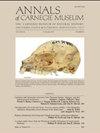西弗吉尼亚州的跳蚤(管翅目)
IF 0.9
4区 地球科学
Q4 PALEONTOLOGY
引用次数: 3
摘要
摘要:在西弗吉尼亚州记录了35种跳蚤,包括新记录的ischnopsyllid, Nycteridopsylla chapini Jordan(1929年)和ctenophthalmid, rodopsylla curvata (Rothschild, 1915年)。接待和分发记录以县为单位呈现,新增记录较多,其中1980年以来累计新增县记录88项。分布最广的蚤是Orchopeas leucopus (Baker, 1904)和Peromyscopsylla hesperomys hesperomys (Baker, 1904),均来自Peromyscus属小鼠。假眼锥虫(Ctenophthalmus pseudoagyrtes, Baker, 1904)在鼩鼱、田鼠和老鼠身上大量存在。松鼠蚤,Orchopeas howardi (Baker, 1895),在该州从西到东的12个县发现,可能在整个州都有。该物种与散发的流行性斑疹伤寒的维持和传播有关。猫蚤,Ctenocephalides felis (bouch本文章由计算机程序翻译,如有差异,请以英文原文为准。
The Fleas (Siphonaptera) of West Virginia
ABSTRACT Thirty-five species of fleas are documented from the state of West Virginia including new state records for the ischnopsyllid, Nycteridopsylla chapini Jordan, 1929, and the ctenophthalmid, Corrodopsylla curvata (Rothschild, 1915). Host and distribution records are presented by county, with many new records, including 88 new county records amassed since 1980. The most widely distributed fleas were Orchopeas leucopus (Baker, 1904) and Peromyscopsylla hesperomys hesperomys (Baker, 1904), both from mice of the genus Peromyscus. Ctenophthalmus pseudagyrtes (Baker, 1904) was abundant on shrews, voles, and mice. The squirrel flea, Orchopeas howardi (Baker, 1895), found in 12 counties from west to east in the state is probably present throughout the state. This species has been implicated in the maintenance and spread of sporadic epidemic typhus. The cat flea, Ctenocephalides felis (Bouché, 1835), a parasite primarily of domestic cats and dogs, was not well represented in our collections, but is widespread geographically and probably occurs throughout the state. This is the most economically important species in West Virginia as a household pest and carrier of several zoonotic human pathogens.
求助全文
通过发布文献求助,成功后即可免费获取论文全文。
去求助
来源期刊

Annals of Carnegie Museum
综合性期刊-动物学
CiteScore
2.50
自引率
18.20%
发文量
4
审稿时长
>12 weeks
期刊介绍:
Annals of Carnegie Museum is a quarterly journal that publishes peer-reviewed short and medium-length original scientific contributions in organismal biology, earth sciences, and anthropology, in 40 by 52.5 pica format (168 by 220 mm or 6-5/8 by 8-5/8 inches). Subject matter must be relevant to Carnegie Museum of Natural History scientific sections or Powdermill Nature Reserve (PNR), preferably with connection to the Carnegie collection and/or personnel. Carnegie Museum staff and research associates receive publication priority, but others are encouraged to submit papers, especially those manuscripts explicitly based on the Carnegie collection.
 求助内容:
求助内容: 应助结果提醒方式:
应助结果提醒方式:


